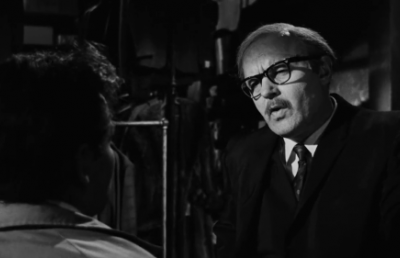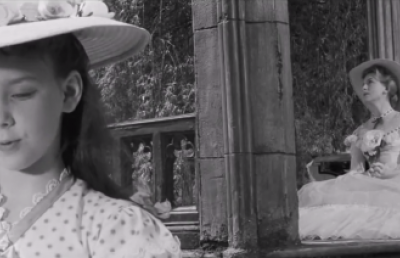Reading Peeping Tom again: Mediated Voyeurism and Fragmented Reality
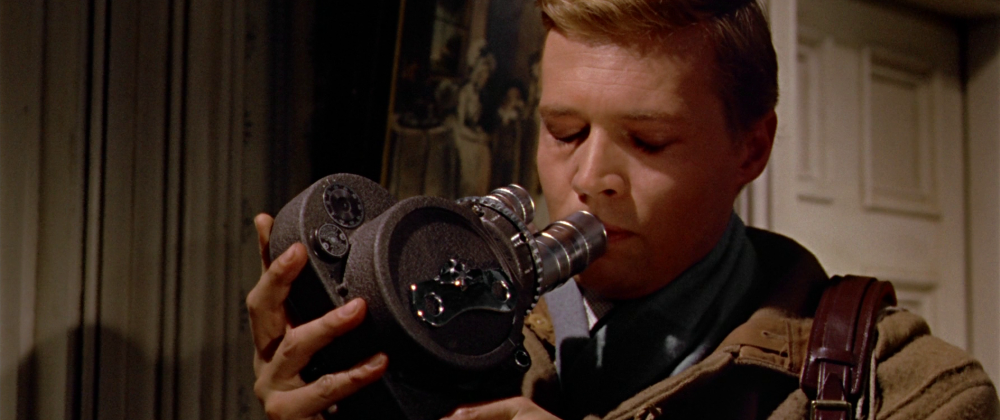
Over the years Peeping Tom, the 1960 film directed by Michael Powell and written by Leo Mark, has assumed a peculiar position in film studies, particularly in the horror field. Mainly regarded as a metaphor of the cinematic gaze for the way masculine hegemony possesses the feminine body 1 , this film has provoked many interpretations and has compelled many to extract theoretical knowledge from it. How we are to approach such a text, filmic or not, and configure what to make of it? Though the film incarnates many intuitions about cinema, in my own reading of it I would like to stay as close as possible to the film itself and the filmmaker’s own discourses on it. I would like to explore structural ideas about the film, for example decoding and voyeurism; and formulate how the film’s discourse relates to scopophilia. This ‘morbid urge to gaze’ pervades the whole film, making it not simply about a murderer that kills women but also about a cameraman, someone who sees life through a lens. And lastly, I would like to open the discussion to what it says about vision and cinema.
Decoding
Leo Marks worked as a cryptographer during the Second World War for the British government. He related how he felt like a voyeur being there, supervising his whole team of cryptographers, who were all, somehow, also voyeurs. He even said that ‘all cryptographers are basically voyeurs.’ 2 In fact, cryptographers unfold the privacy of a code, or nation’s code, breaking it and making it visible. Or they create one. A cryptographer is someone that enciphers or deciphers secret messages. Leo Mark’s peculiar position also gave him the opportunities to observe fear. Linking voyeurism and fear, the film’s idea became a living project. With this cryptographic atmosphere, it invites us to take it as something to decode. As text workers, we break ‘codes’, we make visible something that was unknown or that remained invisible. Breaking ‘codes’ is a metaphor to materialize something as abstract as the act of reading or extracting a meaning from an oeuvre. And, as Jeremy Hawthorn rightfully notes, ‘one unfortunate aspect of this is that readings of the film can easily slip from interpretation to decoding, uncovering precisely those Freudian meanings that screenwriter Leo Marks put into his script in a circular cycle of transformations.’ 3 I don’t aim to decode what is a very substantial oeuvre, but through a close examination of it, initiate a reflection on vision and cinema.
Voyeurism
According to the Diagnostic and Statistical Manual of Mental Disorders (DSM), the psychologists’ bible in diagnosis, etiology and treatment for mental disorders, voyeurism is characterized by a subject showing “over a period of at least 6 months, recurrent, intense sexually arousing fantasies, sexual urges, or behaviors involving the act of observing an unsuspecting person who is naked, in the process of disrobing, or engaging in sexual activity” and that “has acted on these sexual urges, or the sexual urges or fantasies cause marked distress or interpersonal difficulty.” 4 This very specific diagnosis is mainly given to men; little information is available on their behavior or their motivation. Voyeurs are rarely caught due to the furtive behavior and women are either never caught or do not correspond to this specific definition of voyeurism. Thus, no full access to the spectrum is possible or available. The Psychiatric Dictionary widens the definition by adding that voyeurism “is the watching or the later recall of it in phantasy that gives sexual excitement and is an end in itself (although often accompanied by masturbation to effect orgasm).” 5 While still relating firmly to the sexual aspect of voyeurism, it offers a new twist for the understanding of the behavior of a voyeurist. A voyeur either watches directly, or through mediation, through recall. Phantasy leads us to suppose that the mediation is made only through memory, an imaginative mode. Nevertheless a recall can also be made with the means of photographs, films, or sound recording.
Clay Calvert, in Voyeur Nation, is concerned with contemporary mediated voyeurism. Mediated voyeurism takes form through “television, newsmagazines and reality based-shows.” 6 Without dismissing the intrinsic sexual nature of voyeurism, mediated voyeurism is not exactly concerned with that definition. However the DSM offers us the idea of voyeurism as ‘deviant’ and this is what should be kept in mind, for Calvert, as “it suggests that there are some forms of ‘looking’ or ‘watching’ that are not appropriate and that fall outside the boundary of acceptable conduct.” 7 My concerns are not to approach in any way the moral issue at work either in the DSM or in Calvert’s work. But he does make an accurate observation when he underlines that instead of looking at people in a state of nakedness “we observe unsuspecting people in a state of distress.” 8 The act of voyeurism in itself still concerns us, it’s just the object of it that differs and offers us a new clue in revealing Peeping Tom.
Who’s peeping?
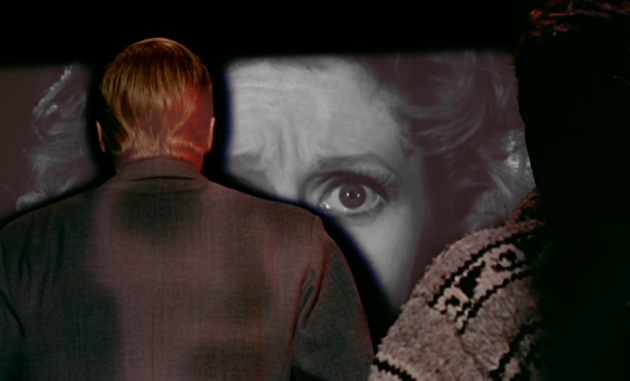
What am I seeing Mark?
The title has a story of its own. Powell and Marks were having a discussion 9 about the term ‘Peeping Tom’ and as Powell decides it should be the film’s title, Marks asked if it wouldn’t attract the ‘wrong’ people. Powell answered that it should attract both ‘good’ and ‘wrong’ people. Adam Lowenstein, in Shocking Representation, in a chapter entitled “Direct Emotional Realism: The People’s War, Classlessness, and Michael Powell’s Peeping Tom”, argues the film as being “class-less” and that it evacuates any discussion on how peeping should relate to any particular class. In fact, the act of peeping represented in the movie is shown under varied forms as the mediated voyeurism suggested, directly or through mediation like in the use of photographs, films and sound recording. It would be a mistake to only consider it from the Mark Lewis character. For example, when the first corpse is found, many people gather around the passageway where the murder occurred trying to sneak a look. Mark is filming their distress and their curiosity as they stand there watching the dead body. People are curiously watching death as Mark is filming their distress. The newsagent shop reveals much of the peeping that we feel is sexually motivated. Pin-up cards are hanging everywhere in the store. A customer, an elderly gentleman played deliciously by Miles Malleson, comes in to buy ‘nudies’ in the guise of buying some respectable newspapers. Mark’s house is also the site of some peeping, starting with Mark looking into the window on the evening of Helen’s birthday.
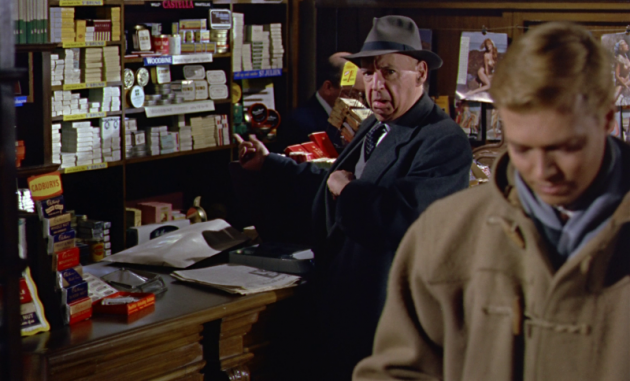
And Helen’s curiosity when watching Mark’s home movie is, to some point, intrusive of Mark’s privacy. Not to forget the moment where she actually is the voyeur looking through window while coming back from the restaurant that special night with Mark. Tony, the other tenant, can’t help himself hold the bathroom door a little too long while Mark and Helen are having a conversation. And what are we to think about Mrs. Stephen who can hear everything Mark is doing in his apartment? It does not relate to image but to sound, yet another form of “peeping”, “listening to doors”; an echo of the father’s machinery of recording displayed throughout the house. These are just a few moments of the film’s enactment of peeping in its diversity.
While researching the title of the movie I encountered the legend of Lady Godiva, a beautiful princess who saved her beloved population taxes by walking (or horseback) naked in her village covered only by her long hair. According to legend everyone refrained from looking except for one person, named Tom, who couldn’t stop himself from looking. This legend was adapted for the screen in 1955 by Arthur Lubin and it starred Maureen O’Hara as the Lady. In this movie, Lady Godiva of Coventry, the ‘Peeping Tom’ gets his eyes burned as a result of the misbehavior. But what is telling about this scene is that the torch points toward the camera, in effect burning the “lens” and making the association between eyes and lens clear. 10
All major dictionaries relate the idiomatic term “Peeping Tom” to the legend of Lady Godiva. They also relate it to the term “voyeur”. In 1768, the Webster’s Third New International Dictionary, refers directly to the legend of Lady Godiva. In 2001, the Random House Webster’s Unabridged Dictionary defines Peeping Tom mainly on the sexual aspect of it. Even the Oxford Dictionary of Current Idiomatic English, published in 1983, renders the idea of the legend as something trivial, defining a Peeping Tom as someone “who furtively and secretly looks into house windows etc. in order to see people undress, make love, etc.” In two hundred and fifty years a shift occurs in our defining what a Peeping Tom is, transferring his central meaning from the legend to a sexual disorder.
Mark as Director
In his memoirs A Life in Movies, in the second volume of the French edition, Powell talks about the French translation of the title of the movie, Le Voyeur, which he thought should have been called Le Cinéaste, saying that it “would have been a better title’.” 11 James Howard in his monograph on Michael Powell recalls what he had said about his film and that it was “not about a diabolical murderer –it’s about a cameraman.” 12 Powell identifies himself with Mark Lewis, the main character of Peeping Tom for he is the ‘absolute’ director, the technician of emotion. 13 The web of references to a very wide and important career, his own, is also mentioned. 14 From the choice of actors who appeared in previous productions (Moira Shearer, Miles Malleson), or allusions such as the dragonfly pin that recalls the opening ballet of The Tales of Hoffman, to the producer figure modeled on John Davis, a producer he has had worked with before. Mark’s character, a focus puller and director of one of the films-within-a-film, incarnates aspects of Michael Powell’s life.
Thinking in Film
In a romantic moment from Peeping Tom, Helen and Mark are in the hallway returning from a date, when she returns to get Mark’s camera. In her absence Mark mimics “photographing” her face, capturing and editing a memory, with his hands framing time and space. The very presence of the camera, which Helen observes is “growing like an extra limb,” defines Mark’s personality. 15 Like a cane for a blind person, an extension of the body; as when one uses a hammer or even a prosthetic, becoming an elongation of the body.
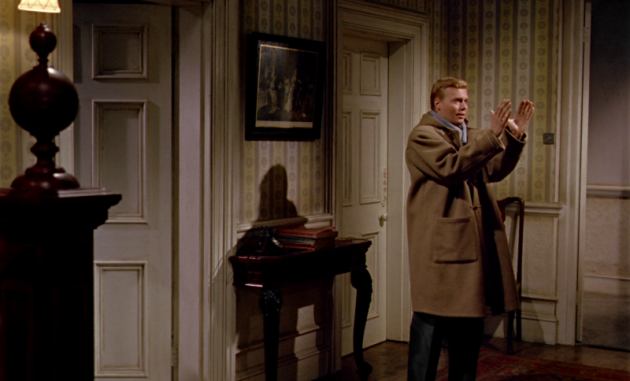
Ursula Le Guin, a writer with whom Powell had had a long correspondence over a possible adaptation her novel, Wizard of Earthsea, recalls him ‘thinking in films’ 16 , making a camera-sight of his hands and looking through it “to frame the scene he was seeing in his mind’s eyes.” 17 His son, Columba Powell, who acted in the film as the young Mark, when interviewed in the 1997’s documentary A Very British Psycho, recalls his father always being with a camera, making home movies. Explicating the link between Mark’s character and Powell’s life gives us a better context for those gestures, and tempers the desire to reduce the movie to its horrible violence and murderous acts.
Blindness and Insight
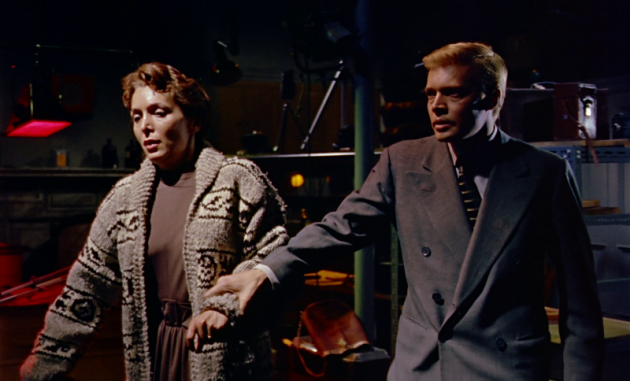
Interestingly, there was a blind person on the set of Peeping Tom, Esmond Knight 18 , the actor that plays Arthur Baden, the director of the film-within-a-film, “The Walls are Closing In”, and one blind character, Mrs. Stephen, Helen’s mother played by Maxine Audley. When giving her instructions on the role, Michael Powell said to Audley: “Just go on doing what you’re doing… be strong, frightened, blind and intuitive… which is what you are! Pity to waste those eyes –but of course, they’re not wasted, are they?” 19 Nothing is a coincidence in Peeping Tom; the movie was carefully planned before shooting. The work that has been done on pairing characters is quite impressive. The film creates a binary system where opposition as well as similarities are enhanced. When observing all the pairs encountered in this film –Mark and his father, Mrs. Stephen and her daughter, Milly and Mark, Vivian and Mark, etc., we find one special pair: the encounter between Mrs. Stephen and Mark. For a character confronting Mark as much as does Mrs. Stephen, blindness is a very allusive component of the binary system. Being blind, at least in fiction, gives a character insight into events that are occurring. 20 Mark and Mrs. Stephen relate to each other through their similarities, 21 like the extension they both need in order to move in the social world, his camera and tripod and her cane. Both extensions possess a sharp end suggesting a more profound common distress.

Thus it’s her blindness that highlights Mark’s incapacity to see and live life without his camera. They are also shown as having a similar dependency on liquids. The whisky she pours follows another liquid, the chemical one from his developing lab, marking their individual dependency on something that releases the distress. Then again, Mrs. Stephen’s first appearance is right after the scene where Milly pours tea, suggesting that Mrs. Stephen is not the only woman to be able to ‘see’ Mark.
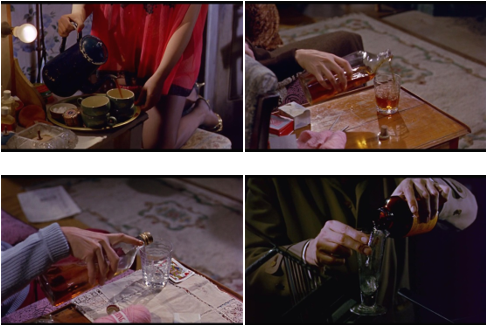
Camera and Focus
The French filmmaker Bernard Tavernier recalls Michael Powell telling him that cinema has to be magic, it has to provoke dream. 22 What’s at stake here is the conception of the medium and art itself. Powell also wrote to Tavernier: “J’ai admiré le réalisme de la photographie, mais maintenant que tu as trouvé le ton et l’effet, essaie d’introduire des tâches de lumières inattendues comme on trouve dans les peintures de la Renaissance. Le vrai n’est pas toujours la Vérité.” 23 If we consider the camera as the main focus of the film, it opens the possibility for us to reflect on the object of filming and it’s relation to what we consider ‘reality’.
The camera is an omnipresent element of the film. Through the camera, and everything surrounding the making of film and its presentation, Powell shows us the entire “film process” (dispositif). 24 The film is a comment on film, not only cinema but also documentary, fiction and the propaganda films made during the Second World War and the realist aesthetic. Adam Lowenstein, in Shocking Representation, explains how the opening street sequence of Peeping Tom reproduces the code from the New Wave and how it possesses implicit violence towards the subject filmed. He writes: “Not only is the camera’s subject explicitly rendered as a vulnerable target, but the black-and-white film itself (a stylistic hallmark of every New Wave production) is revealed as a fetishized construction of reality with no privileged claim on any social truth.” 25 Thus the opening sequence on a prostitute and the subsequent filmed murder and the later projected grainy black-and-white film recalls documentary and realist aesthetic, while subverting it by making the framing visible.
This brings us back to the notion of mediated voyeurism. Although with a different aim, Catherine Zimmer notes that, in the opening scene, Mark’s camera is hidden under his coat. For her “the implication is that the camera is the hidden voyeur, not the man who approaches her.” 26 Insisting on the technology itself and the presence of the camera as a central element of the film’s narrative, she suggests that the crosshairs we see “aim and focus on one particular object, these particular crosshairs also fragment the image.” 27 However, she connects this fragmentation with fetishization, which I suggest is more efficient as a the pretense to produce “reality” through the camera. Fragmentation serves to deconstruct the presupposed idea that camera and filming can produce a real image, can reproduce reality. A framed space is always a part of something larger.
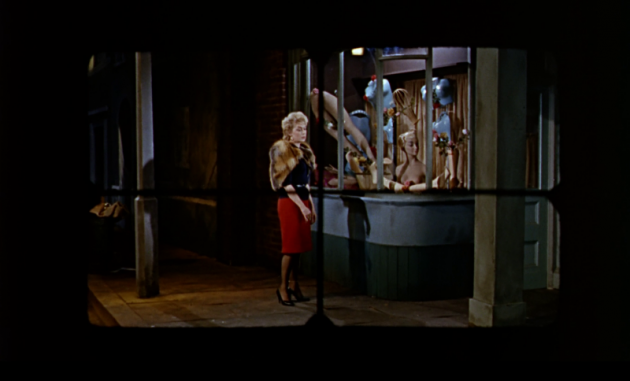
Looking through the lens crosshairs
Subject of film
The romantic moment with Mark and Helen in the hall, suggests something juvenile. One can say that Mark’s character is hardly a sexually mature person. In fact, he doesn’t seem to have yet developed a sexual identity, “[e]motionally, he is still a preadolescent, dominated by the spirit of his father.” 28 In this case, how are we to consider his murders? As sexual acts? Scott Salwolke repudiates this, based on the premise of Mark as a preadolescent, that the camera performs a cinematic rape. Mark is so unthreatening that when Vivian is alone with him, after we have seen her refusing so many invitations, she calls him a ‘boy’.
Mark’s father (played by Powell), a brilliant researcher in the field of behaviorist psychology, was obsessed by his research on fear. He used his son as an experimental subject for his major study on fear and the nervous system, forcing Mark to a traumatic childhood with no privacy. As a behaviorist psychologist, Mark’s father is predominantly preoccupied with visible behaviors. This presence of behaviorist psychology in the film, through the father figure 29 , is not an apology to a school of psychology, behaviorism, that often ruined the lives of patients by using them as subjects without any ethical devices. The affect of this is shown to us and to Helen, when Mark is projecting the ‘home movie’ his father filmed. Inciting traumatic moments for the benefit of his research, or filming while traumatic events occurred, the father used his own son as a subject of research on fear. How not to think about Mark’s practice of filming as a prolongation, or maybe an emulation, of the father’s practice? And more than a prolongation, but a reenactment, bearing fruit of the application of the behaviorist thinking? The repetition of the father’s practice by Mark is not about filming some subject with a lizard; it’s about the essence of the research: fear. Mark is emulating the pattern but also incorporating it as a broken subject of the father’s research.
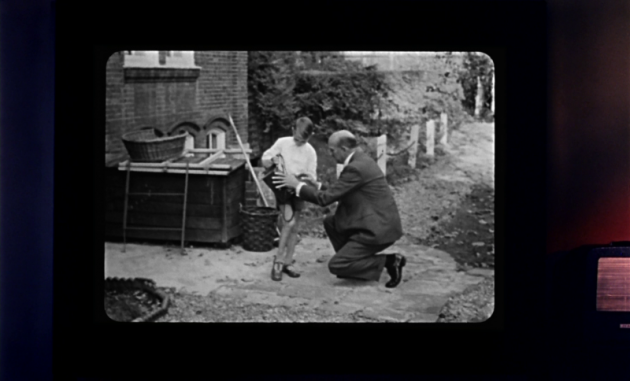
Passing on the trauma of the camera from father to son
Looking through the camera is the only way Mark has can really see. And in order to satisfy the exigencies of an absent, but still present, father, as in the scene with Vivian when he recalls his father, but does not finish his sentence: “The result must be so perfect, that the risk doesn’t count, even he…”. The need to obtain the perfect film, the perfect representation of fear, pure distress, this obsession is motivated by the urge to complete a documentary, which reveals itself as being nothing more than the completion of the father’s work on his subject, Mark. No one else can supply him the perfection he searches.
Film-within-a-film
Odd. How did we (the collective scholarship on this film) end up reading the gaze represented in Peeping Tom as somehow masculine and sexually destructive? Those who are meant to be sexual figures are never ‘truly’ sexualized in this movie. Ironically, Laura Mulvey has written in her comment of the film, The Light That Fails, 30 that the only eroticized moment of the film might be when then mother touches Mark’s face.
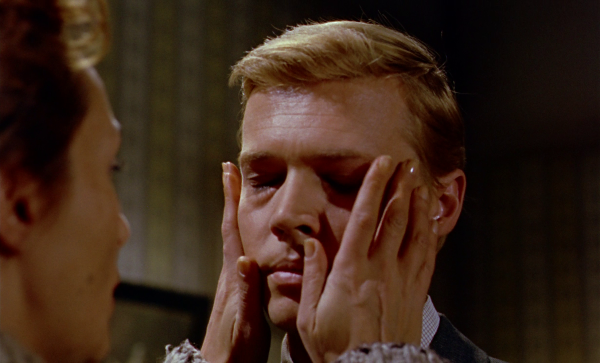
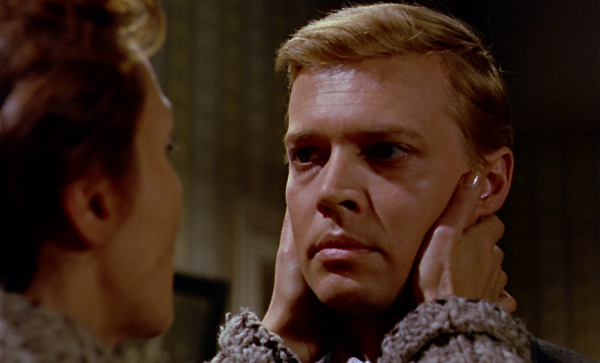
Then what is the purpose of the murderous acts and the presence of the camera? We need to look for the motive of this killing, and filming. The film-within-the-film that Mark is performing is composed of the murders, the search for the perfect representation of fear, but also by the reaction of the people surrounding the murders. Those reactions consist of fear. This is the main object of his film. And as we have said before, the object of voyeurism might not always be sexualized, it could also consist of distress, and fear is an emotion of distress. The gathered people at the passage from the first sequence of the film, to his filming of Lorraine, where the omitted word should have been fear, 31 and the filming of the main actress as she finds the body, is all about capturing fear in the discovering of something ‘unusual’, like death. Mark emulates the subject of his father’s research.
The unfolding of the mise-en-scène of the murders is very curious. It’s a regression and a progression. The crosshairs omnipresent at the beginning will become progressively extinguished from the screen as the murders and their technique are inversely unfolded. The film opens on a murder 32 and closes itself on the main character’s suicide. Dora, who seem to be a prostitute, will be killed in her room, on her bed. We watch it through the crosshairs of the lens, in its entirety. It’s a non-stop sequence shot that we will watch a second time, in black-and-white and without sound, inside Mark’s screening room. The second victim will be Vivian, one of Mark’s colleagues at the studio where he works as a lens puller. She is a stand-in. The complete murder scene is shown to us through the ‘regular camera’. A few scenes with the crosshairs are shown to us but only from the beginning of the sequence. We now know that the stiletto weapon is inserted in the leg of the tripod. It acts as an extension of Mark and permits him to film at the moment the sharp end will enter the victim’s jugular. This sequence is extremely long and anguishing. We know the outcome as we watch her play ‘frightened to death’. The screening of this murder will occur later, with the blind mother present as Mark cries like a child against the white screen, whimpering because “the light fades too soon.” 33 The third murder victim is Milly, the nude model. This death occurs off-screen and the film will not be developed or projected, as “the walls are closing in” (title of the studio film Mark is working on). Finally, the last one is Mark’s suicide where we see the whole set-up unfold.
Collision of Sight and Sound
John Trevelyan, Secretary of the Board of the British Board of Films Censors, from 1958 to 1971, gave the go-ahead at script-stage for Peeping Tom. Something he later regrets as he had to “grant a certificate to a horror film which he found really troublesome.” 34 He initially thought that Peeping Tom was a film about mental illness and that the film would serve the purpose to help understand it. He was outraged by the film. He believed the film deviated from the original approved script. But Michael Powell and Leo Marks had taken care of every detail before filming. Nothing in the production was left to chance. And “comparisons between the submitted script and its celluloid realization demonstrate very little deviation from what was originally approved by the Board.” 35 Something happens from the script to projected film but it is intangible. It’s proper to the cinematic medium; it’s the encounter between images and sound, it’s that “weird magic created on screen by the mystical collision of sight and sound.” 36
When the lens, being an eye, has the pretension to capture reality, what it captures is always a piece of private life. As the ‘peeping tom’ in Lady Godiva of Coventry, the eyes can have access things that should not be seen. How does this film relate to scopophilia, other than its mention by the psychiatrist on the set of “The Walls are Closing In”? Scopophilia is a synonym of voyeurism, this ‘morbid urge to gaze’, and for Peeping Toms, is the love of looking. A looking we do every day as we walk in the streets, looking at window shops, at people, at nature. It’s the morbid urge to gaze at something private, which relates to one’s intimacy. Today, this gaze takes form through mediated voyeurism. It seems to be an intrinsic nature for humans to “peep”. This prognostic doesn’t request any type of censorship; it only works as a notice about the status of fiction in its relating to reality, and, more than ever, horror fiction. In the documentary, A Very British Psycho, Michael Powell’s son asks ‘It’s only a film, isn’t?’ With that trace of doubt in the voice, is it really just a film? Do we act like if it’s just a piece of fiction?
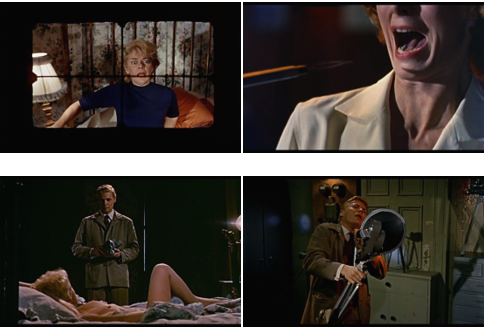
For all that it could be, at least, behaviorism has shown us that behaviors can be induced. The difficulty here is to understand why they chose to give the father those attributes; being a behaviorist researcher, conducting research on fear, using his son as his own subject, etc. When reading Dufour, 37 I came across something that might be a starting point to reflect on this problem. Dufour talks about the cinema of Luc Besson and how he uses fragmentation as a means to escape representation, to be a creator instead of someone that reproduces. Furthermore, he explains that for Besson “il faut que le film procède comme la vie, c’est-à-dire que l’effet se fasse connaître avant la cause.” 38 But this idea of life is one of coincidence, fate and chance where fragmentation serves the purpose to show contingency at work. I would say that Peeping Tom opposes this view in that it tries to express how there might be little contingency at work in Mark’s killing or in any voyeuristic behavior.
In highlighting that engagement one has with reality, Peeping Tom brings us along a journey of vision, cinema, transmission, but also of a society with its norms and deviances or its morbid urge to gaze at the other’s distress. Instead of reproducing stereotypes, the film addresses them and shows the force that the cinematic apparatus possesses. As a comment on cinematic realism and its implicit violence towards the subject filmed, fragmentation, as seen with the lens crosshairs, deconstructs the presupposed idea that camera and filming can produce ‘real’ images of reality. Framing and editing makes us forget that images are always part of something larger.
Bibliography
A Very British Psycho (1997). [Motion Picture].
American Psychiatric Association. (2004). DSM-IV-TR (Fourth Edition, Text Revised ed.). Washington: Wiley.
Calvert, C. (2000). Voyeur Nation : media, privacy and peering in modern culture. Boulder: Westview Press.
Campbell, R. J. (1996). Psychiatric Dictionnary (Seventh edition ed.). Oxford: Oxford University Press.
Delumeau, J. (1978). La peur en occident (XIVe – XVIIIe siècle). Paris: Fayard.
Dufour, É. (2006). Le cinéma d’horreur et ses figures. Paris: Presses universitaires de France.
Hawthorn, J. (2003). Morality, voyeurism and ‘point of view’: Michael Powell’s Peeping Tom (1960). Nordic Journal of English Studies, 2(2), pp. 303-324.
Howard, J. (1996). Michael Powell. London: Batsford.
Kermode, M. (2002). The British censors and horror cinema. In S. Chibnall, & J. Petley (Eds.), British Horror Cinema. London: Routledge.
Lowenstein, A. (2005). Shocking Representation. New York: Colombia Universiy Press.
Lubin, A. (Director). (1955). Lady Godiva of Coventry [Motion Picture].
Mulvey, L. (1975, Autumn). “Visual Pleasure and Narrative Cinema.” Screen, 16(3), pp. 6-18.
Mulvey, L. (2005). The Light That Fails. In I. Christie, & A. Moor, The Cinema of Michael Powell. London: British Film Institute.
Oxford Dictionary of Current Idiomatic English. (1983). Oxford: Oxford University Press.
Powell, M. (Director). (1960). Peeping Tom [Motion Picture].
Powell, M. (1997). Million Dollar Movie, Une vie dans le cinéma 2 (Vol. 2). (J.-P. Coursodon, Trad.) Arles: Actes Sud.
Powell, M. (1997). Une vie dans le cinéma. (J.-P. Coursodon, Trad.) Arles: Actes Sud.
Random House Webster’s Unabridged Dictionary (Second Edition ed.). (2001). New York: Random House.
Salwolke, S. (1997). The Films of Michael Powell and the Archers. Lanham: The Scarecrow Press.
Viviani, C. (2005, Juin). Leo Marks: derrière «Le Voyeur»… Positif (532), pp. 107-108.
Webster’s Third New International Dictionary. (1768). London: William Benton Publisher.
Zimmer, C. (2004). “The Camera’s Eye: Peeping Tom and Technological Perversion.” In S. Hankte, Horror Film: Creating and Marketing Fear. University Press of Mississippi.
Notes
- Mulvey, Visual Pleasure and Narrative Cinema, 1975 ↩
- Lowenstein, 2005) p.60 ↩
- Hawthorn, 2003) p.304 ↩
- American Psychiatric Association, 2004) p.1089 ↩
- Campbell, 1996) p.788 ↩
- Calvert, 2000, p. 49. ↩
- Calvert, 2000, p. 51-52. ↩
- ibid, fn. 6 ↩
- Which is related in (Lowenstein, 2005) p.60 ↩
- Curiously, in 1960, the same year Peeping Tom was released, another film made use of that process, La Maschera del Demonio, a film by Italian director Mario Bava. The scene shows a mask with two holes for the eyes. The mask progressively approaches the camera lens and merges with the spectator gaze. Then the point of view going back in direction toward the woman’s face. The shift in perspective suggest the atrocity of having the mask hammered into the collective face of the audience, but also suggest that the spectator holds the same position as the “witch” being judged and executed her for demonic activities. ↩
- Powell M. Million Dollar Movie, Une vie dans le cinéma 2, 1997), p.507 ’cela aurait été un meilleur titre’. ↩
- Howard, 1996, p. 82. ↩
- Lowenstein, 2005, p.60. I am putting up front the convergence between Michael Powell’s work and Mark’s character, but Leo Mark and Mark’s character are also convergent, as Lowenstein points out, on the voyeuristic aspect and on torture. ↩
- Salwolke, 1997. Bertrand Tavernier, in his preface to the French edition of Powell’s autobiography, A Life in Movies, writes that Peeping Tom is an “autobiographic tale, a fable on cinema done by a lover of cinema.” [[Powell M. , 1997) p.22 ‘Cette fable sur le cinéma faite par un amoureux du cinéma’. ↩
- Salwolke, 1997, p. 224 ↩
- Howard, 1996, p. 94 ↩
- Howard, 1996, p. 94. ↩
- According to Wikipedia, Esmond Knight lost an eye while on service during World War 2, and suffered from varying conditions of blindness for the rest of his career. ↩
- Howard, 1996, p. 83. ↩
- But there is something else with blindness that relates to another binary system; lightness and darkness. “L’aveugle, dit-elle [the Bible], qui ne voit pas ‘la lumière du jour possède un avant-goût de la mort (Tob., 3,17; 11,8; 5,11s).” This citation is taken from the work of Jean Delumeau on fear, La peur en occident (XIVe – XVIIIe siècles) page 87. And might offers a new layer to understand the blind figure in film. ↩
- Another similarity is also to be found in their common interest for “first-hand information” as Mrs. Stephen states when asking about the murder that occurred at the studio. First-hand information isn’t what Mark is seeking. ↩
- M. Powell, 1997, p. 18. ↩
- M. Powell, 1997, p. 20. ↩
- Dufour, 2006, p.185. Dufour’s aim is to point to the voyeuristic position that the spectators holds in this structure. His only concern is with the “apparatus” that’s being revealed at the end with Mark’s death. I enlarged his view since the “apparatus” is actually being shown in its entirety. If there is a voyeur there is an object to look at, and since this object is film, films does not come out of nowhere ↩
- Lowenstein, 2005, p 68. ↩
- Zimmer, 2004, 37. ↩
- Zimmer, 2004, 38. ↩
- Salwolke, 1997, p. 223. ↩
- As well as the mother who talks to Mark about opening up and the psychiatrist who knew the father of Mark ↩
- Mulvey, The Light That Fails, 2005) p.153 ‘This is the only moment in the film that is allowed an erotic edge’. ↩
- Salwolke, 1997, p. 225. ↩
- Or the opening eye sequence . ↩
- They always do, replies Mrs. Stephen, evoking again, the similarities of concerns between Mark and Mrs. Stephen, but also pointing to darkness and death, which will soon occur for Mark ↩
- Kermode, 2002, p. 12 ↩
- Kermode, 2002, p. 12 ↩
- Kermode, 2002, p. 12 ↩
- Dufour, 2005, p. 193 ↩
- Dufour, 2005, p. 193 ↩


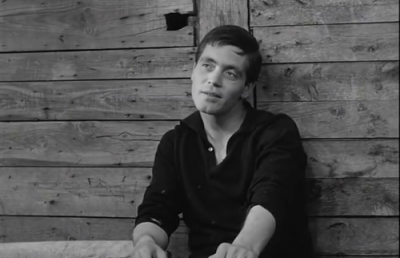
-small_400_258_90_s_c1.jpg)
